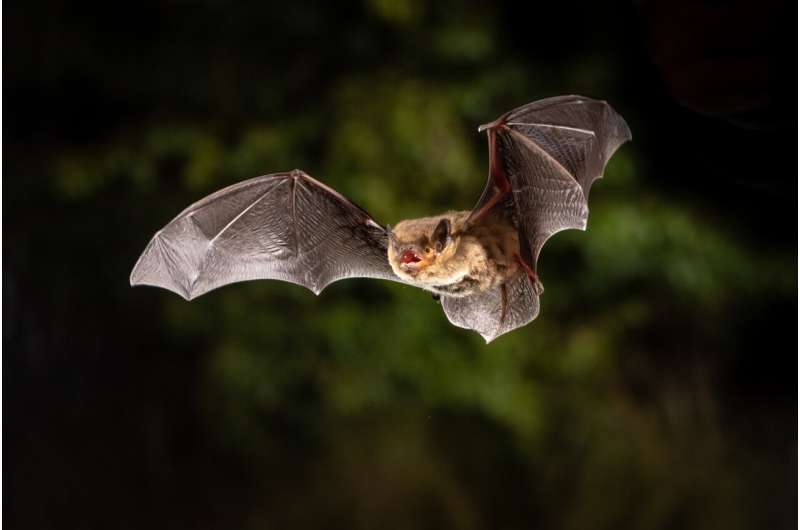This article has been reviewed according to Science X's editorial process and policies. Editors have highlighted the following attributes while ensuring the content's credibility:
fact-checked
peer-reviewed publication
proofread
Migratory bats can detect the Earth's magnetic field, behavioral experiments show

Pipistrelle bats have a magnetic compass and calibrate it at sunset, according to a new study. An international team of researchers led by the University of Oldenburg has used behavioral experiments to show that two different components of the Earth's magnetic field influence the orientation of these animals. Like birds, they seem to be sensitive to magnetic inclination.
The soprano pipistrelle (Pipistrellus pygmaeus) weighs only a few grams, but it is estimated that members of this small bat species cover thousands of kilometers every year on their nocturnal migrations from north-eastern to south-western Europe. Precisely how they find their way across such long distances in the dark remains unclear.
However, an international team led by biologist Dr. Oliver Lindecke from the University of Oldenburg has found evidence suggesting that a magnetic sense may play a role in the bats' navigation. In behavioral experiments, the team discovered that two different components of the Earth's magnetic field influence the animals' orientation. The study has now been published in the journal Biology Letters.
Lindecke has already been studying the migratory behavior of the small mammals for 10 years. "Unlike with birds, so far there has been very little research into the magnetoreception of mammals that migrate over long distances," he explained. Together with earlier findings, the results of the current study indicate that soprano pipistrelles have a magnetic compass that they calibrate at sunset.
Lindecke and his colleagues conducted their experiments at the University of Latvia's Ornithological Station in Pape, a village on the Baltic Sea coast in the far south-west of Latvia. "Tens of thousands of bats migrate along the coast here in August and September, mainly towards Central Europe," Lindecke explains.
He had already discovered in an earlier study that these migratory bats readjust their internal orientation system at sunset: they use the point at which the sun sets for calibration to be able to pick their flight route later that night.
To test whether the bats have a magnetic sense and use it for navigation, the researchers trapped 65 soprano pipistrelles. The following day at sunset, a number of these bats were exposed to a manipulated magnetic field created using a device called a Helmholtz coil. The horizontal component was rotated 120 degrees clockwise in relation to the Earth's magnetic field, such that a compass needle would point south-east rather than north.
With a second group of bats, in addition to the horizontal shift the research team also reversed the inclination of the magnetic field so that it corresponded to the natural values measured in the Earth's southern hemisphere. A third group was used as a control group and exposed only to the natural geomagnetic field in the dunes on Pape beach.
A few hours later the researchers released the bats one by one in a field lab set up inside a Mongolian yurt at the Pape Ornithological station site in order to determine their take-off orientation. Earlier work had already shown that the animals maintain their chosen direction during their nocturnal flights.
The results: about half of the bats in the control group flew southwards, while the other half flew northwards. The two groups exposed to manipulated magnetic fields behaved differently from each other: the bats that had been exposed to a horizontal shift of the magnetic field generally took off in a north-westerly direction. In the group where, in addition to the horizontal shift, the inclination was also reversed, however, no discernible preferred direction of take-off was observed.
These results demonstrate one thing in particular, says Lindecke, "The bats are sensitive to both the magnetic field's horizontal component, known as polarity, as well as its inclination at sunset—and this still influences their take-off behavior several hours later."
Lindecke explained that although it is not yet clear which mechanisms the magnetic compass in migratory bats is based on, the study had shown that, like birds, migratory bats may use the inclination of the Earth's magnetic field for navigation.
More information: William T. Schneider et al, Migratory bats are sensitive to magnetic inclination changes during the compass calibration period, Biology Letters (2023). DOI: 10.1098/rsbl.2023.0181
Journal information: Biology Letters
Provided by Carl von Ossietzky-Universität Oldenburg




















